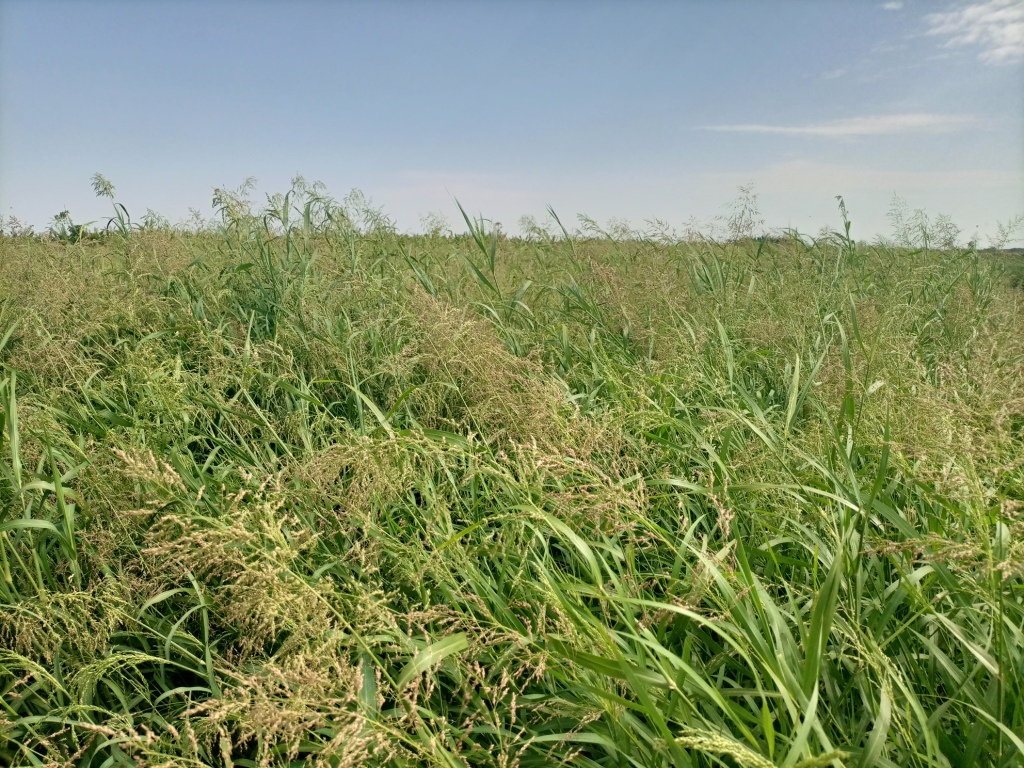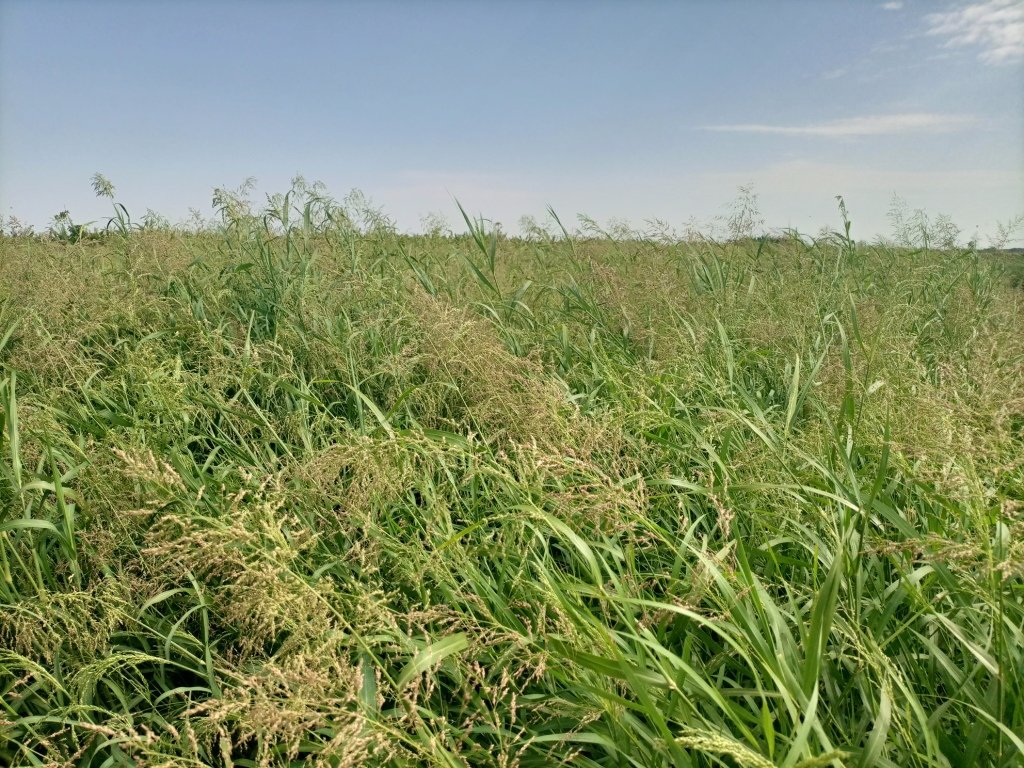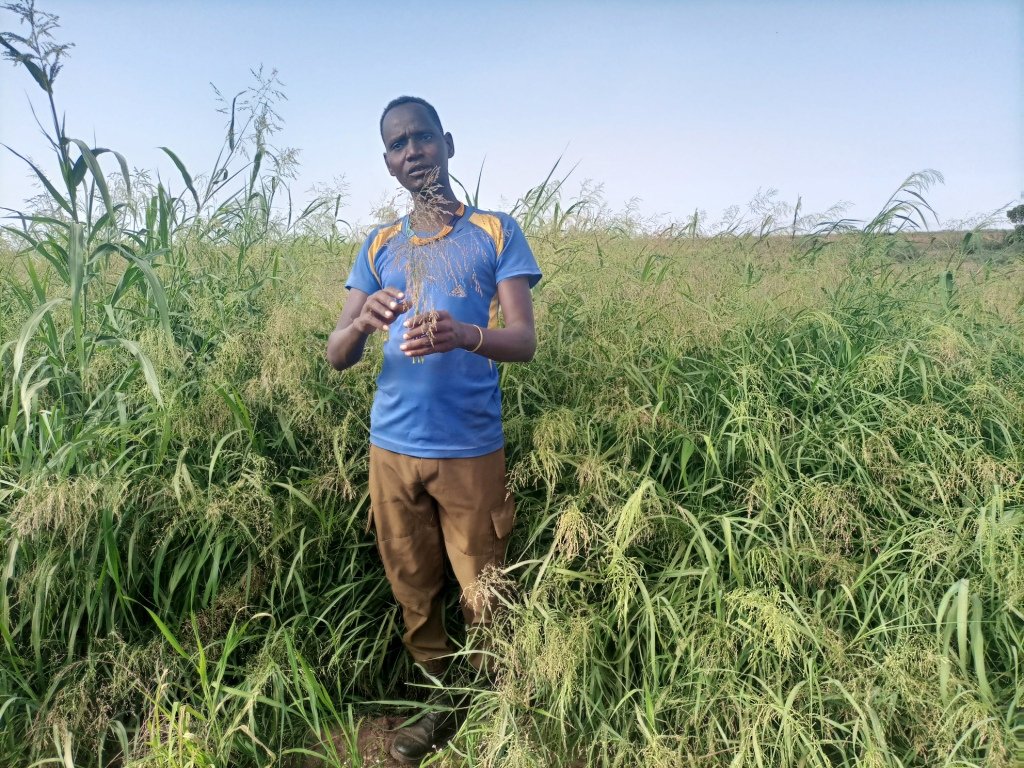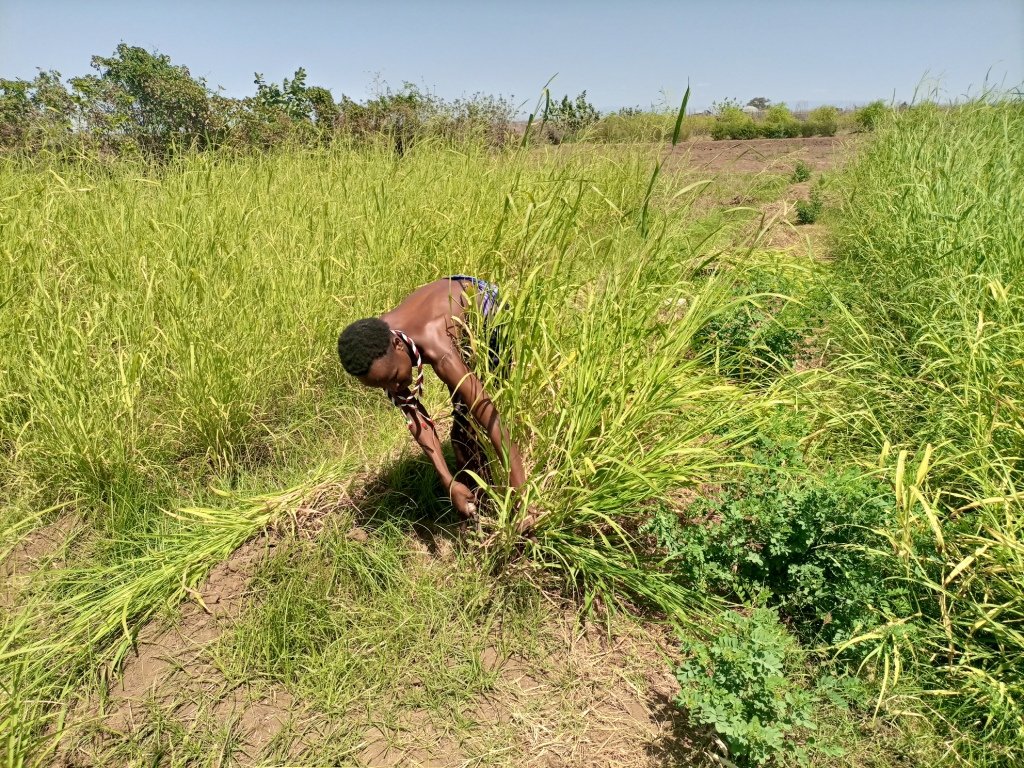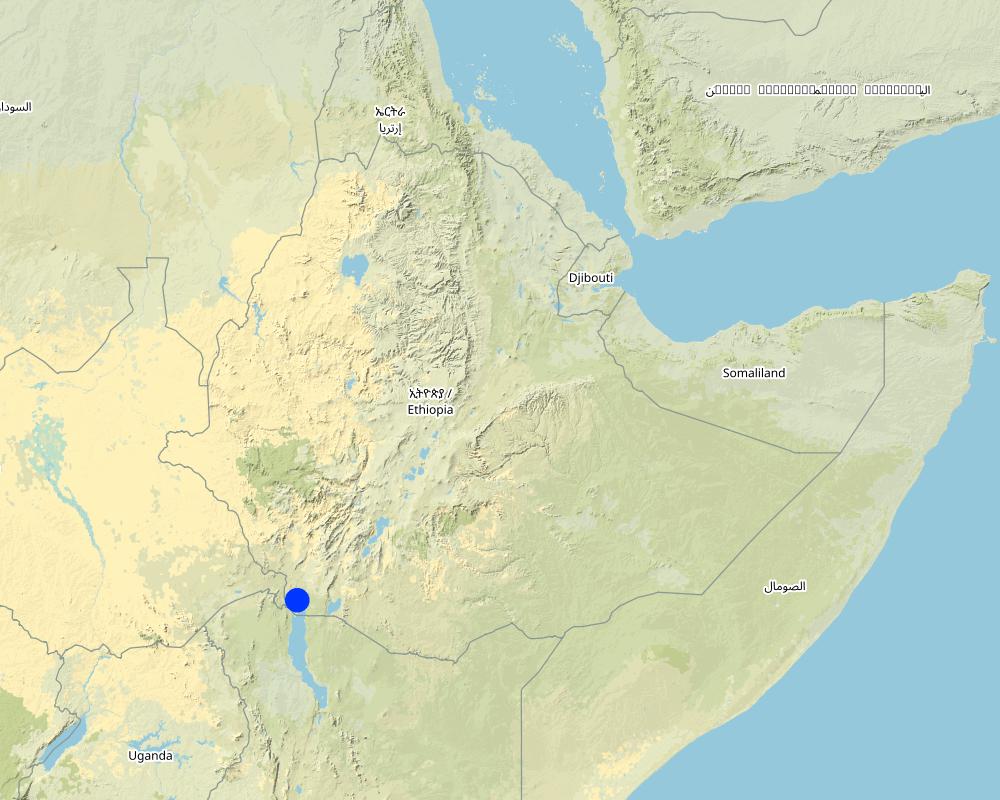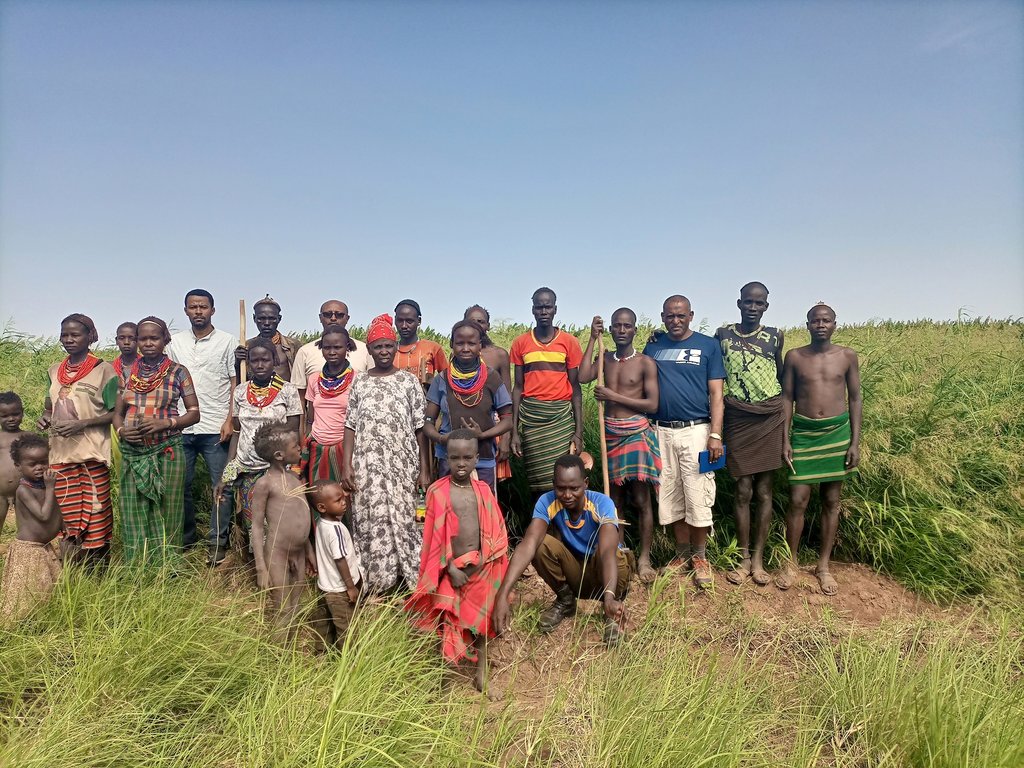Panicum coloratum for irrigated fodder [Etiópia]
- Criação:
- Atualização:
- Compilador/a: GERBA LETA
- Editor: –
- Revisores: William Critchley, Rima Mekdaschi Studer
Panicum
technologies_6563 - Etiópia
Veja as seções
Expandir tudo Recolher tudo1. Informação geral
1.2 Detalhes do contato das pessoas capacitadas e instituições envolvidas na avaliação e documentação da tecnologia
Pessoa(s) capacitada(s)
usuário de terra:
Lutulya Abebe
Agro-pastoralist (fodder producers group leader)
Etiópia
Nome do projeto que facilitou a documentação/avaliação da Tecnologia (se relevante)
Resilient in Pastoralist Areas (RIPA)Nome da(s) instituição(ões) que facilitou(ram) a documentação/ avaliação da Tecnologia (se relevante)
International Development Enterprises - Ethiopia (iDE-Ethiopia) - Estados Unidos1.3 Condições em relação ao uso da informação documentada através de WOCAT
O/a compilador/a e a(s) pessoa(s) capacitada(s) aceitam as condições relativas ao uso de dados documentados através da WOCAT:
Sim
1.4 Declaração de sustentabilidade da tecnologia descrita
A tecnologia descrita aqui é problemática em relação a degradação da terra de forma que não pode ser declarada uma tecnologia de gestão sustentável de terra?
Não
Comentários:
The technology is a regenerative practice friendly to the environment.
2. Descrição da tecnologia de GST
2.1 Descrição curta da tecnologia
Definição da tecnologia:
Panicum coloratum is a palatable tropical grass with high biomass production potential. It is grown in the irrigated fodder development areas of Dassenech district. Panicum is a fast-growing perennial which can be repeatedly harvested once it reaches maturity. It mitigates the issues of recurrent livestock feed shortage in dry periods – which are becoming worse with climate change.
2.2 Descrição detalhada da tecnologia
Descrição:
Irrigated fodder production is carried out by pastoralist groups in arid areas of South Omo. Among a number of fodder grasses, Panicum coloratum is a fast-growing species. Panicum is grown as livestock fodder, particularly for the dry season when feed availability is in short supply. It mitigates the issues of recurrent livestock feed shortages which are becoming worse with climate change. Also, growing fodder grass allows resource-poor pastoralist communities to generate income from the sale of fresh fodder, hay, and seed. Irrigating at least twice a week, good weed management, and fertilization ensure sustained production.
In Dassenech district of Southwest Ethiopia, Panicum’s annual fresh biomass and dry matter production potential is over 63 and 18 tons/ha, respectively. It can reach its first harvest after about 60 days and subsequently can be harvested every 45 days. Panicum germinates and establishes readily on any soil type under both irrigated and rainfed conditions. It is also drought tolerant and resilient to climate variability, and does particularly well on alluvial soils with high fertility. Panicum is mainly used for grazing, but it is also suitable for cut-and-carry feeding systems. Each member of the pastoralist group grows panicum on 0.04 ha of land. In the flood lowlands of the Omo River basin, panicum is known for tolerating periodic flooding, salinity, & disease.
Previously, the land users were unfamiliar with this particular grass and its associated management practices. Also, irrigating on a regular schedule and keeping the grass free from roaming animals adds a work burden to the pastoralist community. However, the Resilience in Pastoral Areas (RIPA) project has introduced and familiarized the community with fodder production and management practices. The project also assists in linking the output to sustainable market. In this regard, the contribution of the RIPA project of the International Development Enterprises (iDE) is immense. The pastoralists appreciate their livestock’s access to year-round feed, as well as the generation of income from the sale of fresh fodder, hay, and seed. Fodder production also creates year-round employment opportunity. However, the community's reliance on government and civic organization support for land preparation and access to irrigation water (conveyance services) might be considered a threat to ensuring sustainability of fodder development by the pastoralist groups.
2.3 Fotos da tecnologia
Observações gerais sobre as fotos:
The photos display panicum seed and feed harvesting.
2.4 Vídeos da tecnologia
Comentários, breve descrição:
Videos of the technology is not documented.
2.5 País/região/locais onde a tecnologia foi aplicada e que estão cobertos nesta avaliação
País:
Etiópia
Região/Estado/Província:
Southern Nations, Nationalities and People Region (SNNPR).
Especificação adicional de localização:
Omorate, Dassenech.
Especifique a difusão da tecnologia:
- Aplicado em pontos específicos/concentrado numa pequena área
O(s) local(is) tecnológico(s) está(ão) localizado(s) em uma área permanentemente protegida?
Não
Comentários:
Panicum production site is closer to the mouth of the Omo river. The technology is piloted in two sites and scaling up sites have been increasing around the irrigable areas.
Map
×2.6 Data da implementação
Indique o ano de implementação:
2021
2.7 Introdução da tecnologia
Especifique como a tecnologia foi introduzida:
- através de projetos/intervenções externas
Comentários (tipos de projeto, etc.):
Resilient Initiatives in Pastoralist Areas project of the International Development Enterprises has implemented fodder development along with other perennial crops such as banana as part of promoting resilient agriculture in the dry areas of South Omo Zone of SNNPRS.
3. Classificação da tecnologia de GST
3.1 Principal/principais finalidade(s) da tecnologia
- Melhora a produção
- Reduz, previne, recupera a degradação do solo
- Reduzir riscos de desastre
- Adaptar a mudanças climáticas/extremos e seus impactos
- Criar impacto econômico benéfico
3.2 Tipo(s) atualizado(s) de uso da terra onde a tecnologia foi aplicada
Uso do solo misturado dentro da mesma unidade de terra:
Não

Terra de cultivo
- Cultura perene (não lenhosa)
Cultivo perene (sem lã) - Especificar culturas:
- banana/planta/abacá
- ervas, pimentão, capsicum
- gramíneas naturais
Número de estações de cultivo por ano:
- 2
Especifique:
The area receive bimodal rainfall but not reliable to grow crops.
O cultivo entre culturas é praticado?
Não
O rodízio de culturas é praticado?
Não

Pastagem
Pastagem extensiva:
- Pastoralismo semi-nômade
Tipo de animal:
- camelos
- gado - leite e carne bovina (por exemplo, zebu)
- caprinos
- ovelhas
É praticado o manejo integrado de culturas e pecuária?
Não
Produtos e serviços:
- segurança econômica, prestígio dos investimentos
- leite
- peles/couros
Espécie:
caprinos
Contagem:
12
Espécie:
gado - leite e carne bovina (por exemplo, zebu)
Contagem:
8
Espécie:
camelos
Contagem:
1
Espécie:
ovelhas
Contagem:
9
Comentários:
The site is pastoralist area who used to rely on flood retreat agriculture in the past. However, due to the construction of Gibe III hydroelectric power dam, the spill over during plenty of rain remain still as artificial lake over thousands of hectare for long period of time. As a result, the conventional agriculture practices abandoned. Thus, a shift to irrigation agriculture is in the process at least to produce fodder crops and other perennial crops such as banana for consumption and market.
3.3 O uso do solo mudou devido à implementação da Tecnologia?
O uso do solo mudou devido à implementação da Tecnologia?
- Sim (Por favor, preencha as perguntas abaixo com relação ao uso do solo antes da implementação da Tecnologia)
Uso do solo misturado dentro da mesma unidade de terra:
Não

Terra de cultivo
- Cultura perene (não lenhosa)
Cultivo perene (sem lã) - Especificar culturas:
- banana/planta/abacá
- ervas, pimentão, capsicum
O cultivo entre culturas é praticado?
Não
O rodízio de culturas é praticado?
Não

Pastagem
Pastagem intensiva/produção de forragem:
- Semiestabulação/sem pastagem
- Pastos melhorados
Comentários:
The area used to receive short rain twice a year. However, rainfall distribution is unreliable. So, the introduced perennial fodder and banana production persist throughout the year using irrigation.
3.4 Abastecimento de água
Abastecimento de água para a terra na qual a tecnologia é aplicada:
- Irrigação completa
Comentários:
Fodder and tropical fruit crop production is entirely practiced using full irrigation from Omo river.
3.5 Grupo de GST ao qual pertence a tecnologia
- Gestão de pastoralismo e pastagem
- Solo/cobertura vegetal melhorada
- Perturbação mínima ao solo
3.6 Medidas de GST contendo a tecnologia

Medidas vegetativas
- V2: gramíneas e plantas herbáceas perenes
Comentários:
Perennial fodder production contributes to SLM through permanent soil cover.
3.7 Principais tipos de degradação da terra abordados pela tecnologia

Erosão do solo pelo vento
- Ed: deflação e deposição

Deteriorização química do solo
- Cs: salinização/alcalinização

Degradação da água
- Ha: aridificação
Comentários:
As a perennial crop, the grass covers the ground permanently and reduces moisture loss to excessive evaporation in the dry areas.
3.8 Redução, prevenção ou recuperação da degradação do solo
Especifique o objetivo da tecnologia em relação a degradação da terra:
- Prevenir degradação do solo
4. Especificações técnicas, implementação de atividades, entradas e custos
4.1 Desenho técnico da tecnologia
Especificações técnicas (relacionada ao desenho técnico):
This is the photo of the pastoralist group. There is no specific sketching that portrays the technology but the following points provide tips for adopters of the technology:
- The land is tilled and harrowed by a tractor for two to three rounds.
- On the third-round ridge and furrow are formed using tractor or hand tools.
- The seeds or splits are planted in rows along the ridge.
- Spacing between ridges varies with the purpose: for haymaking 25 -30 cm and for seed production 50-60 cm to simplify the application of intensive management practice for the latter one.
- The farm/crop should be irrigated twice a week for better production.
- Need Fertilization to ensure good production/harvest.
Autor:
Gerba Leta
Data:
19/08/2022
4.2 Informação geral em relação ao cálculo de entradas e custos
Especifique como custos e entradas foram calculados:
- por área de tecnologia
Indique o tamanho e a unidade de área:
1 timad
Se utilizar uma unidade de área local, indicar fator de conversão para um hectare (por exemplo, 1 ha = 2,47 acres): 1 ha =:
0.25 ha
Outro/moeda nacional (especifique):
Ethiopian Birr (ETB)
Se for relevante, indique a taxa de câmbio do USD para moeda local (por exemplo, 1 USD = 79,9 Real): 1 USD =:
53,438
Indique a média salarial da mão-de-obra contratada por dia:
It is variable based on the types of work (from 50 birr to 100) for half day before the sun gets too hot. That is equivalent to one day in dry lowland areas.
4.3 Atividades de implantação
| Atividade | Periodicidade (estação do ano) | |
|---|---|---|
| 1. | Clearing and land preparation | Any season for irrigated fodder production, |
| 2. | Planting/sowing | During the start of season for irrigation fodder production. |
| 3. | Fertilizing | At planting and at boot height. |
| 4. | Irrigating the farm | Twice a week. |
| 5. | Weeding | Twice starting 3- 4 weeks post planting. |
| 6. | Harvesting the grass (fodder) | During harvest maturity. |
| 7. | Hay making (bailing) | Post harvest. |
| 8. | Seed collection, drying and cleaning | Harvesting season and post harvest. |
Comentários:
As fodder development is based on irrigation, it can be started any time/season of the year.
4.4 Custos e entradas necessárias para a implantação
| Especifique a entrada | Unidade | Quantidade | Custos por unidade | Custos totais por entrada | % dos custos arcados pelos usuários da terra | |
|---|---|---|---|---|---|---|
| Mão-de-obra | Clearing and land preparation | PDs | 12,0 | 200,0 | 2400,0 | 50,0 |
| Mão-de-obra | Planting/sowing | PDs | 5,0 | 100,0 | 500,0 | 100,0 |
| Mão-de-obra | Irrigating the farm | PDs | 14,0 | 200,0 | 2800,0 | 100,0 |
| Mão-de-obra | Weeding (twice a season) | PDs | 10,0 | 100,0 | 1000,0 | 100,0 |
| Equipamento | Spade | Pcs | 1,0 | 500,0 | 500,0 | |
| Equipamento | Hoes | Pcs | 1,0 | 300,0 | 300,0 | |
| Material vegetal | Seed | kg | 4,0 | 300,0 | 1200,0 | |
| Fertilizantes e biocidas | NSP | kg | 50,0 | 50,0 | 2500,0 | |
| Outros | Seed collection, drying and cleaning | PDs | 10,0 | 200,0 | 2000,0 | 100,0 |
| Outros | Harvesting and hay making | PDs | 10,0 | 200,0 | 2000,0 | 100,0 |
| Custos totais para a implantação da tecnologia | 15200,0 | |||||
| Custos totais para o estabelecimento da Tecnologia em USD | 284,44 | |||||
Se o usuário da terra arca com menos que 100% dos custos, indique quem cobre os custos remanescentes:
Other than cost of labor, some inputs and material costs are covered by the RIPA project of the iDE.
Comentários:
Irrigation-based fodder development is in the pilot phase. There is growing interest among the government organization (Woreda Office of Agriculture) to adopt and scale up the promising development. Please note, the cost is estimated only for a season or one round of production. Once reaches its first harvest, Panicum can be harvested every other 45 days onward. Of course, it needs the application of necessary management practices, every season.
4.5 Atividades recorrentes/manutenção
| Atividade | Periodicidade/frequência | |
|---|---|---|
| 1. | Cleaning irrigation ditch | During off-season or before the start of next growing season. |
| 2. | Fertilizer (NSP) | Twice: at the beginning of the season & when the fodder reaches boots height. |
| 3. | Irrigating the farm | Twice a week. |
| 4. | Weeding (2x) | Based on the density or prevalence of weeds. |
| 5. | Seed collection, drying and cleaning | When the seed reaches harvest maturity. |
| 6. | Harvesting and hay making | At harvest and post harvest. |
Comentários:
As there is no structure such as fodder banks, maintenance cost is not documented.
4.6 Custos e entradas necessárias pata a manutenção/atividades recorrentes (por ano)
| Especifique a entrada | Unidade | Quantidade | Custos por unidade | Custos totais por entrada | % dos custos arcados pelos usuários da terra | |
|---|---|---|---|---|---|---|
| Mão-de-obra | Cleaning irrigation ditch | PDs | 5,0 | 200,0 | 1000,0 | 100,0 |
| Mão-de-obra | Irrigating the farm | PDs | 12,0 | 200,0 | 2400,0 | 100,0 |
| Mão-de-obra | Weeding (at least twice during the growing season) | PDs | 10,0 | 100,0 | 1000,0 | 100,0 |
| Mão-de-obra | Seed collection, drying and cleaning | PDs | 10,0 | 200,0 | 2000,0 | 100,0 |
| Equipamento | Harvesting and hay making | PDs | 10,0 | 200,0 | 2000,0 | 100,0 |
| Fertilizantes e biocidas | NSP Fertilizers | kg | 50,0 | 50,0 | 2500,0 | 100,0 |
| Custos totais para a manutenção da tecnologia | 10900,0 | |||||
| Custos totais de manutenção da Tecnologia em USD | 203,97 | |||||
Se o usuário da terra arca com menos que 100% dos custos, indique quem cobre os custos remanescentes:
NA
Comentários:
The cost estimation is only for one irrigation season that may range from 45 days to 60 days or some more including the harvesting and drying of the outputs. Once established, the cost of production is gradually declining.
4.7 Fatores mais importantes que afetam os custos
Descreva os fatores mais determinantes que afetam os custos:
Economic crisis and increasing Inflation rate affect the establishment as well as maintenance costs. Particularly, fuel, fertilizer, and labor costs are consistently changing.
5. Ambiente natural e humano
5.1 Clima
Precipitação pluviométrica anual
- <250 mm
- 251-500 mm
- 501-750 mm
- 751-1.000 mm
- 1.001-1.500 mm
- 1.501-2.000 mm
- 2.001-3.000 mm
- 3.001-4.000 mm
- > 4.000 mm
Especificações/comentários sobre a pluviosidade:
Erratic and unpredictable.
Zona agroclimática
- Semiárido
Rainfall distribution is unreliable to produce crops under rainfed conditions.
5.2 Topografia
Declividade média:
- Plano (0-2%)
- Suave ondulado (3-5%)
- Ondulado (6-10%)
- Moderadamente ondulado (11-15%)
- Forte ondulado (16-30%)
- Montanhoso (31-60%)
- Escarpado (>60%)
Formas de relevo:
- Planalto/planície
- Cumes
- Encosta de serra
- Encosta de morro
- Sopés
- Fundos de vale
Zona de altitude:
- 0-100 m s.n.m.
- 101-500 m s.n.m.
- 501-1.000 m s.n.m.
- 1.001-1.500 m s.n.m.
- 1.501-2.000 m s.n.m.
- 2.001-2.500 m s.n.m.
- 2.501-3.000 m s.n.m.
- 3.001-4.000 m s.n.m.
- > 4.000 m s.n.m.
Indique se a tecnologia é aplicada especificamente em:
- Não relevante
Comentários e outras especificações sobre a topografia:
The site is in the lowland around the mouth of Omo River basin.
5.3 Solos
Profundidade do solo em média:
- Muito raso (0-20 cm)
- Raso (21-50 cm)
- Moderadamente profundo (51-80 cm)
- Profundo (81-120 cm)
- Muito profundo (>120 cm)
Textura do solo (solo superficial):
- Médio (limoso, siltoso)
Textura do solo (>20 cm abaixo da superfície):
- Médio (limoso, siltoso)
Matéria orgânica do solo superficial:
- Médio (1-3%)
Caso disponível anexe a descrição completa do solo ou especifique as informações disponíveis, p. ex. tipo de solo, PH/acidez do solo, nitrogênio, capacidade de troca catiônica, salinidade, etc.
Soil pH is over 7 and the soil is slightly saline alluvial.
5.4 Disponibilidade e qualidade de água
Lençol freático:
> 50 m
Disponibilidade de água de superfície:
Precário/nenhum
Qualidade da água (não tratada):
apenas para uso agrícola (irrigação)
A qualidade da água refere-se a:
água de superfície
A salinidade da água é um problema?
Não
Ocorre inundação da área?
Sim
Regularidade:
Esporadicamente
Comentários e outras especificações sobre a qualidade e a quantidade da água:
Diversion/river water is used for irrigation. There is ample water provide that there is pump to convey the water to the nearby farm. In the rainy season, the river is turbid and full of eroded soil from the upstream catchments. However, the depth of the water table is variable based on the distance of the farm from the edge of the river. Around the main river basin, the water table is shallow but too deep as one go away from the river basin.
5.5 Biodiversidade
Diversidade de espécies:
- Baixo
Diversidade de habitat:
- Baixo
Comentários e outras especificações sobre biodiversidade:
Around the farmland, diversity of crops and vegetation is limited. Away from the farmland, there are a few lowland shrub species and faunas common to the dryland.
5.6 Características dos usuários da terra que utilizam a tecnologia
Sedentário ou nômade:
- Semi-nômade
Orientação de mercado do sistema de produção:
- Subsistência (autoabastecimento)
Rendimento não agrícola:
- Menos de 10% de toda renda
Nível relativo de riqueza:
- Pobre
Indivíduos ou grupos:
- Grupos/comunidade
Nível de mecanização:
- Trabalho manual
- Mecanizado/motorizado
Gênero:
- Homens
Idade dos usuários da terra:
- meia-idade
Indique outras características relevantes dos usuários da terra:
The water pump is used to convey water and the tractor for land preparation. Therefore, a mix of mechanization and manual systems are employed in the area. Irrigation land was allocated to the group but they partitioned and distributed to each member of the group.
5.7 Área média de terrenos utilizados pelos usuários de terrenos que aplicam a Tecnologia
- < 0,5 ha
- 0,5-1 ha
- 1-2 ha
- 2-5 ha
- 5-15 ha
- 15-50 ha
- 50-100 ha
- 100-500 ha
- 500-1.000 ha
- 1.000-10.000 ha
- > 10.000 ha
É considerado pequena, média ou grande escala (referente ao contexto local)?
- Pequena escala
Comentários:
As their animal is freely roaming, only small size of land is permantantly owned around the river side and homestead.
5.8 Propriedade de terra, direitos de uso da terra e de uso da água
Propriedade da terra:
- Grupo
- Indivíduo, não intitulado
Direitos do uso da terra:
- Comunitário (organizado)
- Indivíduo
Direitos do uso da água:
- Acesso livre (não organizado)
Os direitos de uso da terra são baseados em um sistema jurídico tradicional?
Sim
Especifique:
The pastoralist, still freely move and settle where they think appropriate and shift after certain years.
Comentários:
Apart from the irrigable land which are located around the river basin, land is openly accessible to the pastoralist community.
5.9 Acesso a serviços e infraestrutura
Saúde:
- Pobre
- Moderado
- Bom
Educação:
- Pobre
- Moderado
- Bom
Assistência técnica:
- Pobre
- Moderado
- Bom
Emprego (p. ex. não agrícola):
- Pobre
- Moderado
- Bom
Mercados:
- Pobre
- Moderado
- Bom
Energia:
- Pobre
- Moderado
- Bom
Vias e transporte:
- Pobre
- Moderado
- Bom
Água potável e saneamento:
- Pobre
- Moderado
- Bom
Serviços financeiros:
- Pobre
- Moderado
- Bom
Comentários:
Access to facility and the services is mainly to those pastoralist community who are residing closer to the Omorate, the woreda capital.
6. Impactos e declarações finais
6.1 Impactos no local mostrados pela tecnologia
Impactos socioeconômicos
Produção
Produção de forragens
Comentários/especificar:
Access to irrigation water increase the fodder production throughout the year.
Qualidade da forragem
Comentários/especificar:
As the alluvial soil around the river bank is suitable for Panicum, it increases the quality of fodder.
Produção animal
Comentários/especificar:
Increase in livestock production is related to the availability of feed/fodder.
Risco de falha de produção
Comentários/especificar:
Access to irrigation water highly reduced risk of production failure.
Área de produção
Quantidade anterior à GST:
-1
Quantidade posterior à GST:
2
Comentários/especificar:
The land that used to be ideal is now converted to farming.
Gestão de terra
Comentários/especificar:
Panicum as perennial fodder increases ground cover throughout the year and contributes to land management from wind erosion in the dry land areas.
Disponibilidade e qualidade de água
Disponibilidade de água potável
Quantidade anterior à GST:
-3
Quantidade posterior à GST:
1
Disponibilidade de água para criação de animais
Quantidade anterior à GST:
0
Quantidade posterior à GST:
0
Qualidade da água para criação de animais
Quantidade anterior à GST:
0
Quantidade posterior à GST:
0
Disponibilidade de água para irrigação
Quantidade anterior à GST:
0
Quantidade posterior à GST:
0
Qualidade da água para irrigação
Quantidade anterior à GST:
0
Quantidade posterior à GST:
0
Demanda por água para irrigação
Quantidade anterior à GST:
0
Quantidade posterior à GST:
-1
Renda e custos
Rendimento agrícola
Comentários/especificar:
As Panicum is harvested at least six times a year post reaching the first maturity, farm income is significantly increases.
Diversidade de fontes de rendimento
Comentários/especificar:
Income can be generated from the sale of fresh fodder, hay and seeds.
Disparidades econômicas
Quantidade anterior à GST:
-2
Quantidade posterior à GST:
0
Carga de trabalho
Comentários/especificar:
Irrigated fodder production needs intensive management practices. Panicum is perennial fodder that remain on the field all year round. So, irrigating, weeding and looking after the farm... increases the workload.
Impactos socioculturais
Segurança alimentar/auto-suficiência
Quantidade anterior à GST:
-1
Quantidade posterior à GST:
2
Estado de saúde
Quantidade anterior à GST:
-1
Quantidade posterior à GST:
1
Direitos do uso da terra/à água
Quantidade anterior à GST:
0
Quantidade posterior à GST:
0
Oportunidades culturais
Quantidade anterior à GST:
0
Quantidade posterior à GST:
1
Oportunidades de lazer
Quantidade anterior à GST:
0
Quantidade posterior à GST:
0
Instituições comunitárias
Quantidade anterior à GST:
-2
Quantidade posterior à GST:
2
Instituições nacionais
Quantidade anterior à GST:
0
Quantidade posterior à GST:
0
Conhecimento de GST/ degradação da terra
Quantidade anterior à GST:
-2
Quantidade posterior à GST:
2
Atenuação de conflitos
Quantidade anterior à GST:
0
Quantidade posterior à GST:
2
Situação de grupos social e economicamente desfavorecidos
Quantidade anterior à GST:
-2
Quantidade posterior à GST:
1
Impactos ecológicos
Ciclo hídrico/escoamento
Escoamento superficial
Comentários/especificar:
As it permanently covers the ground, it has high likelihoods of reducing surface runoff.
Drenagem de excesso de água
Comentários/especificar:
Improve water drainage.
Evaporação
Comentários/especificar:
Decreases surface evaporation but not transpiration.
Biodiversidade: vegetação, animais
Cobertura vegetal
Comentários/especificar:
The farm remains covered by perennial grass. Irrigating the farm also favor the regrowth of other wild species.
Biomassa/carbono acima do solo
Comentários/especificar:
Above ground biomass is highly increased as described in the description section.
Diversidade vegetal
Espécies exóticas invasoras
Comentários/especificar:
Reduced with increased management practices. Invasive alien species such as Prosopis juliflora is less common in this part of the River basin.
Diversidade animal
Comentários/especificar:
Animal diversity correlates with fodder availability.
Espécies benéficas
Diversidade de habitat
Controle de praga/doença
Clima e redução de riscos de desastre
Impactos da inundação
Impactos da seca
Comentários/especificar:
It reduces the impacts of drought on livestock by providing access to adequate feeds throughout the year.
Emissão de carbono e gases de efeito estufa
Comentários/especificar:
As Panicum increase ground cover and store the carbon above and below the soil surface, it reduces the emission of the carbon.
Velocidade do vento
Comentários/especificar:
It breaks the velocity of wind in the lowland, one of the main issues.
Microclima
Comentários/especificar:
Slightly ameliorate the micro-climate of the area.
6.2 Impactos externos mostrados pela tecnologia
Disponibilidade de água
Quantidade anterior à GST:
0
Quantidade posterior à GST:
0
Caudal confiável e estável em período seco
Quantidade anterior à GST:
0
Quantidade posterior à GST:
0
Cheias de jusante
Comentários/especificar:
It is expected that downstream flooding is reduced as the perennial fodder crop cover the ground throughout the year.
Sedimentação a jusante
Quantidade anterior à GST:
-3
Quantidade posterior à GST:
0
Poluição de água subterrânea/rio
Quantidade anterior à GST:
-1
Quantidade posterior à GST:
0
Capacidade de tamponamento/filtragem
Comentários/especificar:
Permanent ground cover expected to increase the filtering capacity.
Sedimentos transportados pelo vento
Comentários/especificar:
It has expected positive effects of reducing wind transportation.
Danos em áreas vizinhas
Danos na infraestrutura pública/privada
Impacto dos gases de efeito estufa
Comentários/especificar:
As perennial crops cover the ground and absorb the carbon, it has an inevitable positive effects on reducing carbon emission.
Especificar a avaliação dos impactos fora do local (medidas):
The fodder development is a pilot practice. Its up scaling will have a positive off-site effects to the surrounding areas.
6.3 Exposição e sensibilidade da tecnologia às mudanças climáticas graduais e extremos/desastres relacionados ao clima (conforme o ponto de vista dos usuários da terra)
Mudança climática gradual
Mudança climática gradual
| Estação do ano | aumento ou diminuição | Como a tecnologia lida com isso? | |
|---|---|---|---|
| Temperatura anual | aumento | moderadamente | |
| Precipitação pluviométrica anual | redução/diminuição | bem |
Extremos (desastres) relacionados ao clima
Desastres meteorológicos
| Como a tecnologia lida com isso? | |
|---|---|
| Tempestade de vento local | moderadamente |
Desastres climatológicos
| Como a tecnologia lida com isso? | |
|---|---|
| Onde de calor | moderadamente |
| Seca | bem |
Desastres hidrológicos
| Como a tecnologia lida com isso? | |
|---|---|
| Inundação geral (rio) | muito bem |
| Inundação súbita | bem |
Desastres biológicos
| Como a tecnologia lida com isso? | |
|---|---|
| Doenças epidêmicas | bem |
| Infestação de insetos/vermes | bem |
Comentários:
Panicum has drought, flood and disease tolerating feature.
6.4 Análise do custo-benefício
Como os benefícios se comparam aos custos de implantação (do ponto de vista dos usuários da terra)?
Retornos a curto prazo:
levemente positivo
Retornos a longo prazo:
positivo
Como os benefícios se comparam aos custos recorrentes/de manutenção(do ponto de vista dos usuários da terra)?
Retornos a curto prazo:
positivo
Retornos a longo prazo:
muito positivo
Comentários:
The technology was piloted two years ago. The cost of establishing it is partly supported by the RIPA project. Land preparation and conveying irrigation water covered by the local government.
6.5 Adoção da tecnologia
- casos isolados/experimental
Comentários:
So far, the pastoralist piloted the technology through government and NGO support.
6.6 Adaptação
A tecnologia foi recentemente modificada para adaptar-se as condições variáveis?
Não
6.7 Pontos fortes/vantagens/oportunidades da tecnologia
| Pontos fortes/vantagens/oportunidades na visão do usuário da terra |
|---|
| Supply year round feed for the land users' livestock. |
| Allow pastoralists/agro-pastoralists to generate income from the collection and sale of fresh fodder, hay and seed. |
| The technology supplies feed that can be reserved for the emergency time through hay making. |
| Introduction of fodder production technology enables the pastoralist group access usufructs to irrigable land that promotes the changing in farming practices from entirely pastoralist to agro-pastoralist on a gradual basis. |
| Pontos fortes/vantagens/oportunidades na visão do/a compilador/a ou de outra pessoa capacitada |
|---|
| The technology considered as one of the regenerative agricultural practices that have positive contribution to carbon sequestration. |
| It reduces risks of feed shortage during the extended dry season. |
| A prompt sources of income for the pastoralist community via the sale of fresh fodder, hay, and seed. |
| Feeding livestock on grass reduces methane production as compared to feeding them on processed feeds. |
| The onsite shattering of the seed increases the density of grass every other season. Thus, it improves the ground cover and production of huge biomass per unit of land. |
| Panicum harvested 15 cm high that simplify regrowth/tillering and propagation of the grass from the ratoon. The practice stimulates prompt ground cover and year-round sequestration of carbon. |
6.8 Pontos fracos, desvantagens/riscos da tecnologia e formas de superá-los
| Pontos fracos/desvantagens/riscos na visão do usuário da terra | Como eles podem ser superados? |
|---|---|
| Access to irrigation facility and service is via government and project support. | Try to secure multiple sources of finance, and encourage market oriented production to enhance the pastoralist groups develop reliance on their own. |
| Smaller size of land is accessible to irrigation. | Increase intensification of fodder development and diversify sources of income via production and marketing of fresh fodder, hay, and the seed. |
| Shortage of baling machine to fasten the hay for simplicity of storage and transportation | Improve pastoralist access to the facility and services so that their resilience to feed shortage and associated issues are promptly increases. |
| Pontos fracos/vantagens/riscos na visão do/a compilador/a ou de outra pessoa capacitada | Como eles podem ser superados? |
|---|---|
| Shortage of storage structure or fodder bank to store/ reserve the harvest for market and/or later uses. | To promote the establishment of storage or fodder bank by the land users group themselves, and try to find sources of finance to support them in this regard. |
| Lack of sustainable market links for Panicum seed. | Establish reliable market value chain with private suppliers/distributors to the other part of the country. |
| Lack of legume fodder species to improve the dietary value of the grass family. | Introduces important legume species with high biomass production potential or other leguminous tree species with multiple uses such as windbreak or as buffer plants around the periphery of the fodder farm. |
| Panicum needs longer time to reach harvest if intended for seed production that may dishearten the pastoralist to wait longer time. | Allocate separate plots for seed production, or else, make the right choice for the types of outputs that suits the pastoralist's urgent needs. |
7. Referências e links
7.1 Métodos/fontes de informação
- visitas de campo, pesquisas de campo
Over 20 members of the pastoralists group are met.
- entrevistas com usuários de terras
One knowledgeable land user who is representative of the pastoralists group.
- entrevistas com especialistas em GST
Three
- compilação de relatórios e outra documentação existente
Published articles and locally developed guideline for growing Panicum.
Quando os dados foram compilados (no campo)?
20/08/2022
Comentários:
Field visit was made from 17 August to 19, 2022.
7.2 Referências às publicações disponíveis
Título, autor, ano, ISBN:
ILRI. 2013. Colored Guinea grass (Panicum coloratum) for livestock feed on small-scale farm. ILRI Forage Factsheet.
Disponível de onde? Custos?
Free online
Título, autor, ano, ISBN:
Hidosa, D., Hitiso, W. & Guyo, M. 2017. Biomass Production of different grass species available at irrigated lowland of Dassench woreda in Southwestern Ethiopia. Bangladesh Journal of Animal Science, 46 (3): 188-191.
Disponível de onde? Custos?
Free online
Título, autor, ano, ISBN:
Hidosa, D., Adicha, A., Sultan, M., 2022. Production and Commercialization Status of Improved Panicum Grass Cultivation in the Lowland Livestock Production System of South Omo South-Western Ethiopia. Research on World Agricultural Economy, 3 (4): 694. DOI:10.36956/rwae.v3i4.694
Disponível de onde? Custos?
Free online
7.3 Links para informações on-line relevantes
Título/ descrição:
Tropical Forage. 2020. Panicum coloratum
URL:
https://www.tropicalforages.info/text/entities/panicum_coloratum.htm
7.4 Comentários gerais
The questionnaire is very comprehensive and inclusive to socio-economic and environmental benefits, and the effects of a specific SLM technology.
Links e módulos
Expandir tudo Recolher tudoLinks
Não há links
Módulos
Não há módulos


